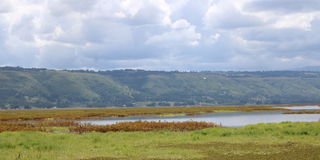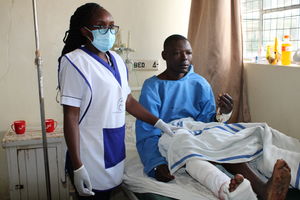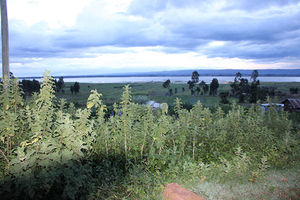Lake Olbolosatt sees remarkable recovery, but…

A canopy of invasive weeds covering the revived Lake Olbolosatt on November 14, 2024.
What you need to know:
- Migratory birds are back for breeding and tourism activities are once again picking up.
When the effects of climate change started to be seen and felt around the world, Lake Olbolosatt, the only highland lake in the Central region, was one of the biggest natural resource casualties.
With prolonged drought and years of monumental destruction of forest cover and water catchment areas within the Aberdare Forest, the lake faced imminent extinction, with water levels reducing to an all-time low of less than 10 per cent.
The drought saw pastoralist communities from the neighbouring Laikipia, Samburu and Baringo counties migrate to areas surrounding the lake. This made the lake a centre of conflicts between herders and local farmers.
Apart from the herders from neighbouring counties, dairy farmers from Ndaragua, Ol Joro Orok and Kipipiri constituencies also brought their livestock to graze around the lake’s riparian area, adding to the thousands of livestock relying on the 43-kilometre squared lake.
In 2023, the lake’s water levels plummeted to less than 10 per cent capacity. But with improved rainfall at the Aberdare Forest and rehabilitation of the water catchment area, the lake is now over 50 per cent full. Further, livestock has vanished as the lake reclaims its riparian land.
Migratory birds are back for breeding and tourism activities are once again picking up.
But the party might be short-lived if drought hits again unless authorities evict illegal and illegally licensed farmers from the Aberdare Ranges, cancel their licences, or force them to adhere to recommended irrigation water pipe sizes.
“The recovery of the lake encourages us. Our efforts as a government, the local community, and development partners over the years have yielded positive results. But we are still concerned by water obstruction at the Aberdare Forest. It’s only the Water, Irrigation, and Sanitation Cabinet Secretary who can address the issue since the licensing is done by national government entities without the consultation of the county government,” says Nyandarua Water, Environment Conservation and Climate Change Executive Wachira Mugo.
He also wants the Senate to urgently discuss and approve Nyandarua County’s proposal for managing natural resources.
“We submitted the proposal to the Senate almost two years ago, long before we submitted the Climate Change Action Plan to Nyandarua Assembly, which swiftly debated and passed the law, paving the way for the implementation of actions to protect and conserve the lake among other natural resources. We need the goodwill of the Senate and Water, Irrigation and Sanitation Ministry to rehabilitate the lake fully,” he adds.
Mr Stephen Kimondo, a pastor at Faith Manifestation Church, Ndaragua Parish, is among the farmers who migrated to graze at the expansive water body.
He abandoned his farm at New Hope Village in Ndaragua to save his cows from imminent death due to prolonged drought. "It was not easy grazing at the lake, we had thousands of cattle from outside the county. The pasture conflict was real, the herders from outside had better financial muscle and connections in high places, and they used those connections to try to force us out of the lake. Lake Olbolosatt and it’s riparian land was the only place left for grazing. We were not happy that the lake had dried up, but it was the only option we had.
Mr Kimondo recalls how he nearly lost seven dairy cows as conflicts over the pastures escalated.
The drought also caused serious human-wildlife conflicts as hippos invaded farms, migrating as far as Ol Kalou to live in smaller dams while at the same time raiding farms for food.
But now the hippos are back home, troubling no one, as young people earn a living canoeing visitors and fishing.
For investors, they have taken advantage of the swelling waters to reopen hotels, with a number of nyama choma structures doting the area.
But these developments have also brought another challenge of waste disposal as hawkers targeting local and international visitors flood the place, according to the Community Organisation for Positive Impact, Care and Development, a community-based environment conservation group.
The group’s CEO Thomas Macharia notes that to protect marine life, the county government needs to establish a clear, enforceable waste management policy around the lake.
“More than five million people in Nyandarua, Laikipia, Samburu, Isiolo and Wajir rely on Lake Olbolosatt for livelihoods and their livestock. We must protect and conserve the lake; we are willing to partner with the county government on waste disposal and management within the lake and its surroundings, but a clear policy must exist,” says the conservationist.





